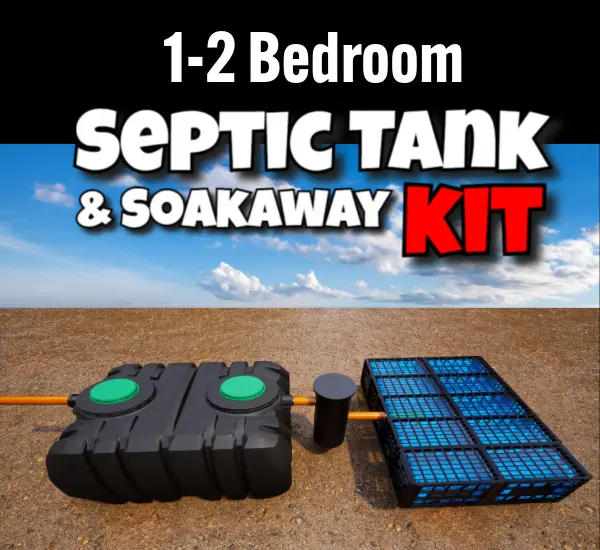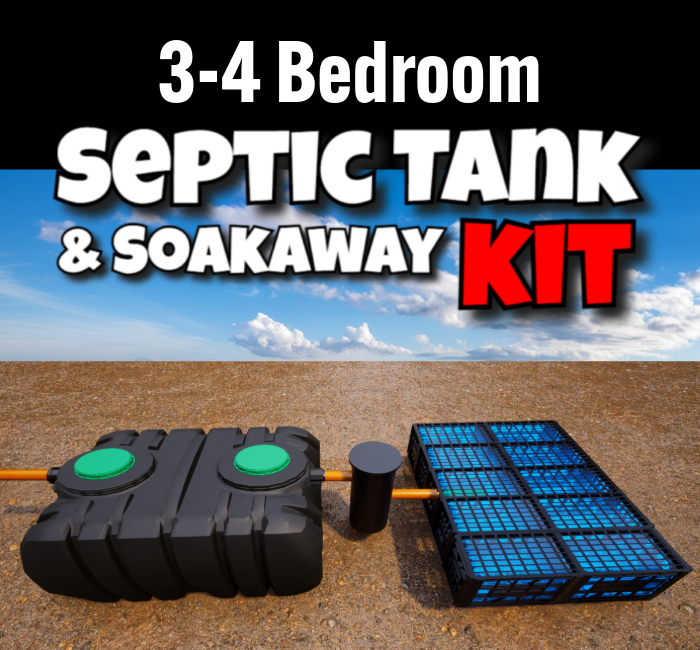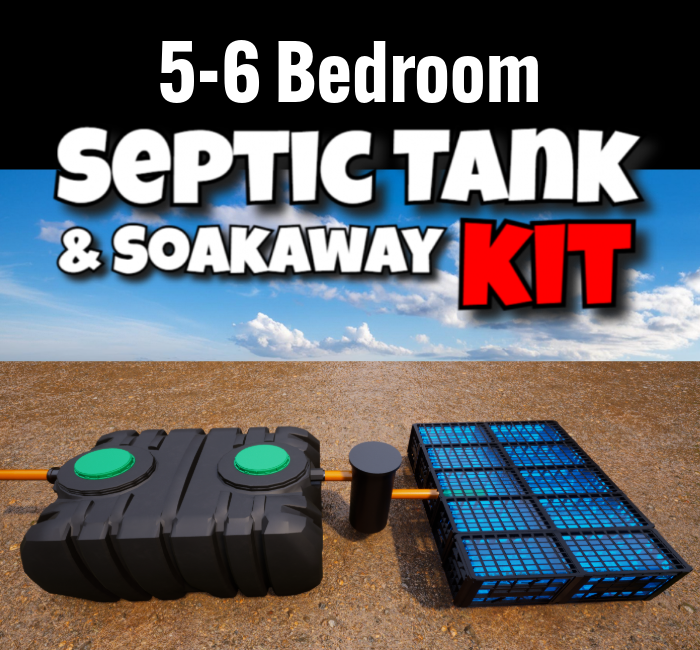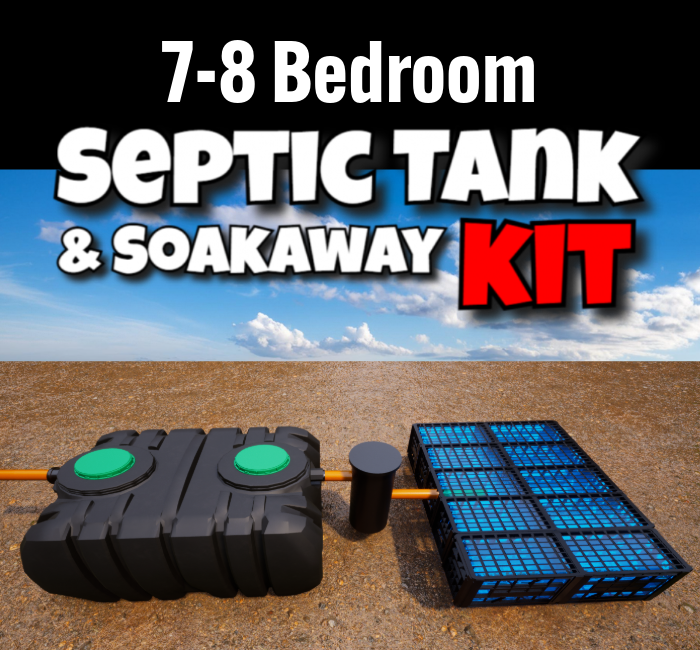Scientific White Paper and Case Study: Septic Tank Installation in the UK – A Comparative Analysis of Materials, Methods, and Cost Efficiency
Abstract
Septic tank installation is a critical aspect of wastewater management for off-mains properties in the UK, governed by stringent regulations such as the Environment Agency’s General Binding Rules and UK Building Control standards. This white paper provides a comprehensive analysis of septic tank types (plastic, fibreglass, concrete), installation methods, and cost comparisons, with a focus on innovative shallow dig, low-profile septic tank kits with drainage field crates. Through a detailed case study, we explore the efficacy and cost savings of these kits, which offer a DIY-friendly, regulation-compliant solution. The paper evaluates how such kits, exemplified by those available from Builders Yard UK, can save homeowners and installers £10,000–£15,000 compared to traditional professional installations costing £12,000–£18,000. By integrating scientific principles, regulatory insights, and practical data, this study aims to inform stakeholders about sustainable, cost-effective wastewater management options.
1. Introduction
In the UK, approximately 15% of households rely on private wastewater systems due to their location off the mains sewerage network []. Septic tanks are a cornerstone of these systems, treating domestic wastewater through anaerobic digestion and dispersing effluent via drainage fields. However, traditional septic tank installations, particularly those using large concrete “onion” tanks, are costly, time-consuming, and environmentally disruptive, with professional installations averaging £12,000–£18,000 [].
Recent advancements in septic tank design, such as shallow dig, low-profile tanks paired with drainage field crates, have revolutionized the industry. These kits, available from reputable suppliers like Builders Yard UK, offer a cost-effective, DIY-friendly alternative that complies with the Environment Agency’s General Binding Rules and UK Building Regulations []. This white paper examines the scientific and practical advantages of these kits, comparing them to traditional systems and presenting a case study to illustrate their real-world application.
2. Septic Tank Types: Materials and Characteristics
Septic tanks are constructed from three primary materials: plastic (high-density polyethylene, HDPE), fibreglass (glass-reinforced plastic), and concrete. Each material has distinct properties affecting durability, installation, and cost.
2.1 Plastic (HDPE) Septic Tanks
- Composition: Made from high-density polyethylene, a lightweight, corrosion-resistant polymer.
- Advantages:
- Lightweight: Facilitates transport and installation, reducing labour and equipment costs [].
- Corrosion Resistance: Ideal for wet or acidic soils, common in the UK [].
- Cost-Effective: Typically priced between £2,000–£5,000, significantly lower than concrete [].
- Shallow Dig Design: Kits like those from Builders Yard UK require only 1–1.5m excavation, minimizing disruption [].
- Disadvantages:
- Less robust in high-traffic areas unless reinforced.
- May require anchoring in high water table areas to prevent buoyancy [].
- Applications: Suitable for small to medium properties, including 1-2 and 3-4 bedroom homes, as seen in Builders Yard’s 1-2 Bedroom Septic Tank Soakaway Kit and 3-4 Bedroom Septic Tank Soakaway Kit.
2.2 Fibreglass Septic Tanks
- Composition: Constructed from glass-reinforced plastic, combining strength with moderate weight.
- Advantages:
- Strength-to-Weight Ratio: Stronger than plastic, suitable for areas with vehicle traffic [].
- Corrosion Resistance: Long lifespan (30–50 years) with proper maintenance [].
- Moderate Installation Ease: Lighter than concrete, requiring less heavy machinery [].
- Disadvantages:
- Higher cost (£3,000–£7,000) compared to plastic [].
- Potential for cracking if improperly installed [].
- Limited availability compared to plastic or concrete [].
- Applications: Ideal for medium to large properties or challenging soil conditions, such as those requiring Builders Yard’s 5-6 Bedroom Septic Tank Soakaway Kit.
2.3 Concrete Septic Tanks
- Composition: Reinforced concrete, often spherical (“onion” tanks) for structural integrity.
- Advantages:
- Durability: Lifespan exceeding 50 years, resistant to buoyancy in high water tables [].
- Heavy-Duty Applications: Suitable for large properties or commercial sites [].
- Disadvantages:
- High Cost: £5,000–£10,000, plus additional expenses for concrete surrounds (£1,000–£2,000) [].
- Deep Excavation: Requires 2–3m depth, increasing labour and time [].
- Heavy Weight: Needs cranes or heavy machinery, escalating installation costs [].
- Cracking Risk: Susceptible to damage in unstable soils [].
- Applications: Best for high-capacity needs, such as large estates, though less common for DIY due to complexity.
2.4 Comparison Table: Septic Tank Materials
| Feature | Plastic (HDPE) | Fibreglass | Concrete |
|---|---|---|---|
| Cost | £2,000–£5,000 | £3,000–£7,000 | £5,000–£10,000 |
| Weight | Lightweight | Moderate | Heavy |
| Installation Time | 3–6 hours | 6–12 hours | 1–2 days |
| Durability | 25–50 years | 30–50 years | 50+ years |
| Corrosion Resistance | High | High | Moderate |
| Excavation Depth | Shallow (1–1.5m) | Moderate (1.5–2m) | Deep (2–3m) |
| Best For | DIY, small gardens, clay soil | Heavy traffic areas | High water tables, large sites |
Source: Adapted from industry data [,].
3. Innovative Septic Tank Kits: Design and Components
Modern septic tank kits, such as those offered by Builders Yard UK, integrate advanced design features to reduce costs, simplify installation, and ensure regulatory compliance. These kits are particularly appealing to homeowners and installers seeking alternatives to traditional installations costing £12,000–£18,000 [].
3.1 Components of Builders Yard UK Septic Tank Kits
Each kit includes:
- Heavy-Duty, Shallow Dig, Low-Profile Septic Tank: 3000-litre capacity for 1-2 and 3-4 bedroom kits, 4000-litre for 5-6 and 7-8 bedroom kits, with a compact footprint [].
- 110mm Underground Pipes: Five 3-meter lengths for wastewater transport.
- 110mm Connectors: Ensure secure, leak-free connections.
- Drainage Field Crates: 8–14 crates depending on kit size, offering a high-void-ratio (95%) soakaway compared to 30–40% for traditional gravel soakaways [].
- Free Membrane: Enhances drainage field efficiency.
- Inspection Chamber: 320mm chamber for maintenance access [].
3.2 Key Features and Benefits
- Shallow Dig Design: Requires only 1–1.5m excavation, compared to 2–3m for concrete tanks, reducing digger hire and labour costs [].
- No Concrete or Electricity: Backfilled with soil or gravel, eliminating £1,000–£2,000 in concrete costs [].
- Rapid Installation: Takes ~3 hours using a 1.5, 3, or 5-tonne digger, suitable for DIY or local builders [].
- Clay Soil Compatibility: Drainage field at 500mm depth avoids dense clay layers, improving effluent dispersal [].
- Regulatory Compliance: Approved by UK Building Control and the Environment Agency, adhering to General Binding Rules [].
- Cost Savings: Priced at £3,499–£4,999, kits save £10,000–£15,000 compared to professional installations [].
3.3 Attenuation Crates
Builders Yard UK also offers attenuation crates for stormwater management, available in configurations for 4 to 100 persons (e.g., 4 pop, 6 pop, up to 100 pop). These modular plastic units store and slowly release stormwater, complementing septic systems in flood-prone areas. Approved by UK Building Control and the Environment Agency, they enhance site compliance and versatility [].
4. Installation Process and Cost Analysis
4.1 Traditional Septic Tank Installation
Traditional installations, often using concrete onion tanks, involve:
- Deep Excavation: 2–3m depth, requiring large diggers and extended labour [].
- Concrete Surround: Adds £1,000–£2,000 in materials and labour [].
- Herringbone Soakaways: Larger footprint, less efficient in clay soils due to deeper placement (≥1000mm) [].
- Professional Labour: Costs £5,000–£7,000, with total installation averaging £12,000–£18,000 [].
- Time: 1–2 days, increasing disruption [].
4.2 Shallow Dig Septic Tank Kit Installation
Builders Yard UK kits streamline the process:
- Excavate: Dig a 1–1.5m deep hole using a 1.5, 3, or 5-tonne digger [].
- Place Components: Position the tank, inspection chamber, and 8–14 drainage field crates.
- Connect Pipework: Link the tank to the house drain and drainage field using 110mm pipes and connectors.
- Backfill: Cover with soil or gravel, no concrete required.
- Test: Check for flow and leaks [].
- Time: ~3 hours, reducing labour costs [].
- Cost: £3,499–£4,999 for the kit, plus ~£500 for digger hire and £0–£500 for labour, totaling £3,999–£5,999 [].
- Savings: £10,000–£15,000 compared to professional installations [].
4.3 Case Study: DIY Installation of a 7-8 Bedroom Septic Tank Kit
Location: Rural Kent, UK
Property: 7-bedroom family home, clay soil, off-mains sewerage
Objective: Replace a failing concrete septic tank with a cost-effective, compliant solution.
Solution: The homeowner selected the 7-8 Bedroom Septic Tank Soakaway Kit from Builders Yard UK, costing £4,999, including a 4000-litre HDPE tank and 14 drainage field crates.
Process:
- Day 1: Hired a 3-tonne digger (£500) and excavated a 1.5m deep hole.
- Day 2: A local builder (£500) installed the tank, inspection chamber, and crates, connected the pipework, and backfilled with gravel. Installation took 3.5 hours.
- Testing: Verified flow and leak-free connections.
Outcomes:
- Total Cost: £5,999 (£4,999 kit + £500 digger + £500 labour).
- Savings: £12,001 compared to a quoted professional installation of £18,000.
- Performance: The drainage field at 500mm depth ensured efficient effluent dispersal in clay soil, outperforming the previous herringbone soakaway.
- Compliance: Approved by local authorities, meeting General Binding Rules [].
Conclusion: The kit provided a sustainable, cost-effective solution, demonstrating the viability of DIY installations for large properties.
5. Regulatory Compliance and Environmental Considerations
5.1 UK Regulations
Septic tank installations must comply with:
- General Binding Rules: Effluent must discharge to a drainage field, not watercourses. Systems installed before 2015 discharging to watercourses require upgrades by 2030 [].
- UK Building Regulations (Part H): Specifies sizing, installation, and maintenance standards [].
- British Standards (BS 6297:2007+A1:2008, EN 12566-1): Ensures tank design and performance [].
- Environment Agency Permits: Required for discharges >2m³/day or in sensitive areas [].
5.2 Environmental Benefits of Shallow Dig Kits
- Reduced Soil Disturbance: Shallow excavation (1–1.5m) minimizes ecological disruption compared to 2–3m for concrete tanks [].
- Efficient Effluent Dispersal: Drainage field crates provide 95% void space, enhancing biological treatment and reducing groundwater contamination risk [].
- Clay Soil Performance: Positioning at 500mm depth avoids dense clay, improving drainage and reducing pollution [].
6. Cost Comparison and Economic Impact
6.1 Cost Breakdown
- Traditional Installation:
- Tank: £5,000–£10,000
- Excavation: £2,000–£3,000
- Labour: £5,000–£7,000
- Concrete Surround: £1,000–£2,000
- Total: £12,000–£18,000 []
- Builders Yard UK Kit:
- Kit: £3,499–£4,999
- Digger Hire: £500
- Labour: £0–£500
- Total: £3,999–£5,999
- Savings: £10,000–£15,000
6.2 Economic Impact
The adoption of DIY septic tank kits can significantly reduce financial burdens for rural homeowners, small businesses, and developers. For example, the 5-6 Bedroom Septic Tank Soakaway Kit and 3-4 Bedroom Septic Tank Soakaway Kit cater to diverse property sizes, making cost-effective solutions accessible. This democratization of wastewater management aligns with sustainable development goals, reducing reliance on costly professional services [].
7. Frequently Asked Questions (FAQ)
Q1: What is included in a Builders Yard UK septic tank kit?
A: Each kit includes a heavy-duty, shallow dig, low-profile septic tank (3000L for 1-2/3-4 bedrooms, 4000L for 5-6/7-8 bedrooms), five 110mm pipes, connectors, 8–14 drainage field crates, a membrane, and an inspection chamber. These components ensure compliance and ease of installation [].
Q2: How long does installation take?
A: Installation typically takes ~3 hours using a 1.5, 3, or 5-tonne digger, suitable for DIY or local builders. No concrete or electricity is required [].
Q3: Are these kits compliant with UK regulations?
A: Yes, they are approved by UK Building Control, the Environment Agency, and adhere to General Binding Rules, ensuring hassle-free planning permission [].
Q4: Can the kits work in clay soil?
A: Absolutely. The drainage field, positioned 500mm below the surface, avoids dense clay layers, ensuring efficient effluent dispersal [].
Q5: How much can I save compared to professional installation?
A: Kits cost £3,499–£4,999, with total installation costs of £3,999–£5,999, saving £10,000–£15,000 compared to professional installations averaging £12,000–£18,000 [].
Q6: What are attenuation crates, and how do they complement septic tanks?
A: Attenuation crates, available in 4–100 pop configurations, manage stormwater by storing and slowly releasing it, preventing flooding. They are approved by UK Building Control and complement septic systems in flood-prone areas [].
8. Conclusion
Shallow dig, low-profile septic tank kits with drainage field crates represent a paradigm shift in UK wastewater management. By leveraging lightweight materials like HDPE, compact soakaway systems, and DIY-friendly designs, these kits—available from Builders Yard UK—offer significant cost savings (£10,000–£15,000) compared to traditional installations. Their compliance with General Binding Rules and British Water Guidelines ensures environmental safety and regulatory adherence. The case study demonstrates their practical efficacy, making them a viable solution for homeowners, businesses, and developers seeking sustainable, cost-effective wastewater management.
For more information or to explore kit options, visit Builders Yard UK’s Septic Tank Collection, including the 1-2 Bedroom, 3-4 Bedroom, 5-6 Bedroom, and 7-8 Bedroom Septic Tank Soakaway Kits.
References
- Environment Agency. (2021). General Binding Rules: Small Sewage Discharge to the Ground. https://www.gov.uk/guidance/general-binding-rules-small-sewage-discharge-to-the-ground [].
- UK Planning Portal. (n.d.). Building Regulations Part H: Drainage and Waste Disposal. https://www.planningportal.co.uk/ [].




